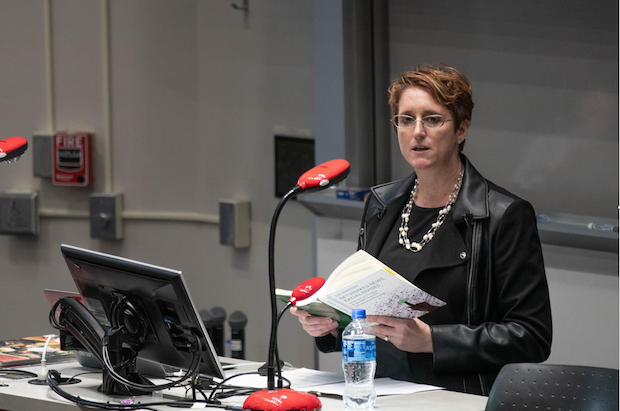
This article is authored by Damian Radcliffe, the Carolyn S. Chambers professor of journalism at the University of Oregon and Destiny Alvarez a journalism master's student at the University of Oregon’s School of Journalism and Communication.
Susan Robinson, a University of Wisconsin-Madison journalism professor, is on a self-professed racial journey. A journey she says all journalists should take.
"Journalists [need] to start appreciating their own identities, their own race, their own religion, their own income background, all of their privileges and also all of the ways they don’t have privilege," she said.
"All of their implicit biases, all the places they feel discriminated against, and understanding that whole mess that is us, is going to be brought into those professional communication settings and to constantly be aware of that during production."
In her latest book, she explores "how pervasive black-white disparities pair with vitriolic public conversation in politically progressive communities throughout America. Networked News, Racial Divides examines obstacles to public dialogues about racial inequality and opportunities for better discourse in mid-sized, liberal cities."

Research findings
Robinson began to ask new questions about Madison’s media ecology, exploring whose voices are being heard, who is being influenced and how journalists and policymakers connected.
"I grew up white and without a whole lot of race issues," Robinson said. "I was completely not woke." As a result, she realised that she had little to no outside networks - namely marginalised voices - that could help her understand race and education policy issues.
Robinson began to recognise that the power, privilege and biases, implicit and explicit, she had as a white woman. It helped her look past the influencers in media-saturated communities and really see voices of colour who were not being heard because of powerful and privileged white influencers.
After seven years of detailed research, Robinson found that distrust reigns in communities that follow standard narratives and did not question traditional power and communication structures.
Robinson concluded that when journalists fail to penetrate network circles for communities of colour and underrepresented voices, as well as allowing their privilege to drive the narratives of the information flow, important voices were left behind.
Her research also found that all the people normally identified as powerful influencers - like superintendents or school board members - were typically only influential voices in the mainstream news and not in other spaces.
Implications for journalists
Based on her research, Robinson found journalists on deadline or contending with other newsroom pressures, tend to communicate with people in clearly defined hierarchies shut out important perspectives. It does not have to be that way.
"Journalists have a lot of power,” Robinson said. “They aren’t just going to be this cog in the machine. They’ll feel like it, but in fact, they have a lot of agency to change things up."
Here are Robinson’s top ten recommendations for doing just that:
1. Collaborate and network both online and offline with those who can act as a liaison between communities. They can be bridges into conversations and groups left behind or underserved in news coverage.
2. Be mindful of identity constructions like “we are progressive [and therefore] we are not racist” narratives.
3. Educate yourself, family and friends on systems and racial disparities in the communities you cover. From the government to the school system there is always another story.
4. Listen and believe when marginalised people talk. They have important concerns and could have been [and could be] affected by systems or policy differently to you.
5. Be aware of reporting models within your own organisation. Does your publication leave out voices? Talk with your editors and learn how to bring training into your newsroom.
6. Draw from different perspectives in your research for reports, ads, journalism, etc.
7. Think about power models, question structures and examine your biases. Be self-aware, as well as woke.
8. Follow through when you call upon marginalised communities for input. Building those relationships is key to building trust.
9. Echo and support those marginalised in your classes or workplaces. Speak up when you witness micro-aggressions or see content that negatively impacts marginalised communities because it is biased or problematic.
10. Admit your mistakes and be willing to give up power.
The reflections in this article stem from the University of Oregon’s “Demystifying Media” seminar series; and conversations by the authors with Dr. Robinson. The Demystifying Media series gives faculty, students and staff the opportunity to hear from those working at the cutting-edge of practice and research.
Dr. Susan Robinson, the University of Wisconsin-Madison Helen Firstbrook Franklin professor of journalism research chair, presented the second lecture of the spring 2019 series, discussing her book, "Networked News and Racial Divides: how power and privilege shape progressive communities."
Free daily newsletter
If you like our news and feature articles, you can sign up to receive our free daily (Mon-Fri) email newsletter (mobile friendly).
Related articles
- How to get started with user needs: learnings from the Reuters Institute, Metro.co.uk and smartocto
- Rachel Duffy, senior social media editor of The Telegraph, on using Reddit for news
- Recruiting for inclusion: a guide for media organisations
- Behind the award-winning web-doc Manchester Maze
- Who to follow: 27 women covering the independent publishing sector









